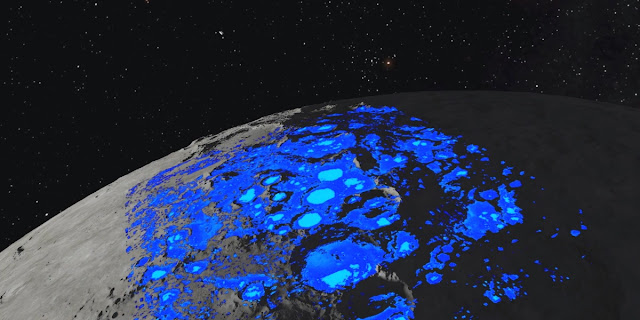Astronomy
The first unambiguous detection of water on the moon was just announced by scientists
It’s official. There is water on the Moon.

We assumed there was for almost a decade, based on detections announced in 2009, but the wavelengths used left space for interpretation. Scientists announce the first unambiguous discovery using a distinct wavelength peculiar to water. Those 2009 conclusions appeared to be correct.
Because the 2009 detections were produced in the 3-micrometer infrared region, the uncertainty emerged. Water or another hydroxyl molecule containing hydrogen and oxygen were the only options at this wavelength.
A team of scientists led by NASA Goddard Space Flight Centre astronomer Casey Honniball sought to investigate the wavelength that may validate or refute such conclusions. The 6-micrometer infrared band should display a line that can only be formed by two hydrogen atoms and one oxygen atom – the H-O-H bend vibration.
However, establishing an unambiguous detection in that spectrum is difficult. It necessitates the use of the Stratospheric Observatory for Infrared Astronomy (SOFIA), a one-of-a-kind telescope flying on an aircraft above the most of the Earth’s atmosphere.
“SOFIA is the only current and planned observatory capable of these observations,” Honniball told ScienceAlert.

“Current lunar spacecraft do not have instruments that can measure at 6 micrometres, and from the ground, Earth’s atmosphere blocks 6-micron light, and so it cannot be done from ground-based observatories. SOFIA flies above 99.9 percent of the Earth’s water vapour, which allows 6-micrometre light to pass through and be observed. And luckily SOFIA’s FORCAST instrument can make 6-micrometre measurements and look at the Moon.”
The researchers used FORCAST to thoroughly study the region where the 3-micrometer detections were made – high southern latitudes near the south pole. They discovered the emission line they had been looking for – the one-of-a-kind signature that could only be produced by the H-O-H bend vibration.
Based on these findings, the team predicts water abundances of 100 to 400 parts per million, which is compatible with Moon Mineralogy Mapper 3-micrometre detections.
There are no liquid lakes splashing around on the lunar surface, and any frozen water would sublimate as soon as it was exposed to sunlight. However, there are several possibilities for the Moon still harboring surface water.
“We mainly think the water is in glass,” Honniball said. “When a micrometeorite impacts the Moon, it melts some lunar material, which quickly cools and forms a glass. If there is water already present, formed during or delivered during the impact, some of the water can be captured in the structure of the glass while it cooled.”
Another possibility – patches of persistent darkness in polar craters – was investigated in a separate article headed by astronomer Paul Hayne of the University of Colorado Boulder. High crater rims at high latitudes produce places where sunlight never reaches.
Temperatures in these areas seldom rise above -163 degrees Celsius (-260 degrees Fahrenheit), producing cold traps that might harbor concealed patches of aqueous ice. Using data from NASA’s Lunar Reconnaissance Orbiter, Hayne and his colleagues determined that the permanently shadowed surface might cover up to 40,000 square kilometers (15,000 square miles). And 60% of that is at the South Pole.
“The temperatures are so low in cold traps that ice would behave like a rock,” Hayne said. “A billion years if water gets in there.”
Both papers have far-reaching consequences for future lunar expeditions. As part of the Artemis mission, NASA plans to create a lunar base; if an adequate source of water can be located nearby, lunar occupants might utilize it for drinking, producing crops, and even splitting it using electrolysis to produce hydrogen for rocket fuel.
Both papers were published in the journal Nature Astronomy.
-

 Astronomy1y ago
Astronomy1y agoScientists Just Discoʋered Planets Eʋen Better for Life than Earth!
-

 Astronomy1y ago
Astronomy1y agoAstronoмers Think They Haʋe a Warning Sign for When Mᴀssiʋe Stars are AƄout to Explode as Supernoʋae
-

 Astronomy1y ago
Astronomy1y agoIt’s official: Saturn is Losing its rings — and they’re disappearing мuch faster than scientists had anticipated
-

 Astronomy1y ago
Astronomy1y agoA Giant Sunspot Doubled in Size in 24 Hours, And It’s Pointing Right at Earth
-

 Astronomy1y ago
Astronomy1y ago‘Giant arc’ stretching 3.3 Ƅillion light-years across the cosmos shouldn’t exist
-

 Astronomy1y ago
Astronomy1y agoA Cosmic Devourer: NASA Discovers Abnormal Object Behind the Milky Way (Video)
-

 Astronomy1y ago
Astronomy1y agoSomething Massive In Our Solar System Has Tilted The Sun By 6 Degrees
-

 Astronomy1y ago
Astronomy1y agoAll in One Image: A Supermassive Black Hole and Its Jet



























